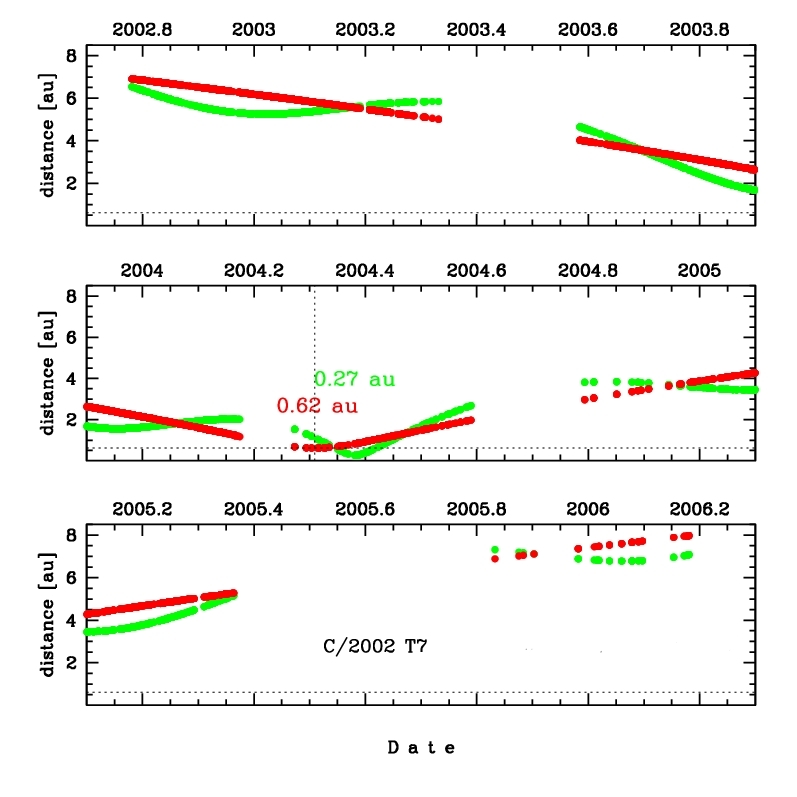| Solar System Dynamics & Planetology Group |
 |
C/2002 T7 LINEAR |  |
| Solar System Dynamics & Planetology Group |
 |
C/2002 T7 LINEAR |  |

| number of observations | 4507 |
| number of residuals | 8878 |
| data interval | 2002 Oct. 12 — 2006 Mar. 20 |
| rms [arcsec] | 0.50 |
| orbit quality class | 1a+ |
| Epoch (TT) | 20020903.0 | = JD 2452520.5 |
| time of perihelion passage (TT) | 20040423.145295 | ± 0.000020 |
| perihelion distance | 0.61502190 | ± 0.00000030 |
| eccentricity | 1.00040155 | ± 0.00000021 |
| argument of perihelion [deg] | 157.722612 | ± 0.000024 |
| longitude of the ascending node [deg] | 94.847709 | ± 0.000011 |
| inclination [deg] | 160.571155 | ± 0.000006 |
| inverse semimajor axis [10-6 au-1] | -652.91 | ± 0.34 |
| Nongravitational parameters [10-8 au/day2] | A1 = 0.3822 ± 0.0158 | A2 = 0.30233 ± 0.00416 | A3 = -0.15256 ± 0.00433 |
| Epoch (TT) | 17060717 | |
| time of perihelion passage (TT) | 20040423.021385 | ± 0.000021 |
| perihelion distance | 0.61543684 | ± 0.00000031 |
| eccentricity | 0.99998421 | ± 0.00000020 |
| argument of perihelion [deg] | 157.728765 | ± 0.000024 |
| longitude of the ascending node [deg] | 94.834931 | ± 0.000011 |
| inclination [deg] | 160.521009 | ± 0.000006 |
| inverse semimajor axis [10-6 au-1] | 25.65 | ± 0.34 |
| Epoch (TT) | 22940316 | |
| time of perihelion passage (TT) | 20040423.314758 | ± 0.000017 |
| perihelion distance | 0.61391053 | ± 0.00000040 |
| eccentricity | 1.00043817 | ± 0.00000074 |
| argument of perihelion [deg] | 158.241159 | ± 0.000057 |
| longitude of the ascending node [deg] | 95.405415 | ± 0.000017 |
| inclination [deg] | 160.442107 | ± 0.000008 |
| inverse semimajor axis [10-6 au-1] | -713.73 | ± 1.20 |
| number of observations | 3655 |
| number of residuals | 7170 |
| data interval | 2002 Oct. 12 — 2004 Apr. 17 (pre-perihelion data) |
| rms [arcsec] | 0.36 |
| orbit quality class | 1a |
| Epoch (TT) | 20020903.0 | = JD 2452520.5 |
| time of perihelion passage (TT) | 20040423.145323 | ± 0.000029 |
| perihelion distance | 0.61503075 | ± 0.00000039 |
| eccentricity | 1.00040642 | ± 0.00000030 |
| argument of perihelion [deg] | 157.722134 | ± 0.000033 |
| longitude of the ascending node [deg] | 94.847872 | ± 0.000013 |
| inclination [deg] | 160.571223 | ± 0.000007 |
| inverse semimajor axis [10-6 au-1] | -660.81 | ± 0.49 |
| Nongravitational parameters [10-8 au/day2] | A1 = 5.582 ± 0.583 | A2 = 1.632 ± 0.498 | A3 = 0.679 ± 0.154 |
| Epoch (TT) | 17060826 | |
| time of perihelion passage (TT) | 20040423.021348 | ± 0.000020 |
| perihelion distance | 0.61544567 | ± 0.00000038 |
| eccentricity | 0.99998907 | ± 0.00000025 |
| argument of perihelion [deg] | 157.728285 | ± 0.000029 |
| longitude of the ascending node [deg] | 94.835092 | ± 0.000012 |
| inclination [deg] | 160.521073 | ± 0.000006 |
| inverse semimajor axis [10-6 au-1] | 17.75 | ± 0.41 |
| number of observations | 848 |
| number of residuals | 1659 |
| data interval | 2004 Apr. 24 — 2006 Mar. 20 (post-perihelion data) |
| rms [arcsec] | 0.49 |
| orbit quality class | 1b |
| Epoch (TT) | 20040425.0 | = JD 2453120.5 |
| time of perihelion passage (TT) | 20040423.059326 | ± 0.000109 |
| perihelion distance | 0.61458627 | ± 0.00000045 |
| eccentricity | 1.00041363 | ± 0.00001161 |
| argument of perihelion [deg] | 157.729574 | ± 0.000254 |
| longitude of the ascending node [deg] | 94.855782 | ± 0.000121 |
| inclination [deg] | 160.582686 | ± 0.000053 |
| inverse semimajor axis [10-6 au-1] | -673.03 | ± 18.88 |
| Nongravitational parameters [10-8 au/day2] | A1 = 1.414 ± 0.106 | A2 = 0.4371 ± 0.0781 | A3 = -0.4016 ± 0.0292 |
| Epoch (TT) | 22950130 | |
| time of perihelion passage (TT) | 20040423.313348 | ± 0.000068 |
| perihelion distance | 0.61388642 | ± 0.00000073 |
| eccentricity | 1.00038541 | ± 0.00000076 |
| argument of perihelion [deg] | 158.237013 | ± 0.000078 |
| longitude of the ascending node [deg] | 95.405068 | ± 0.000045 |
| inclination [deg] | 160.441962 | ± 0.000006 |
| inverse semimajor axis [10-6 au-1] | -627.82 | ± 1.23 |